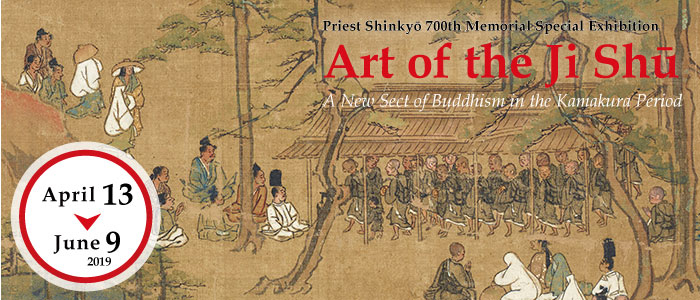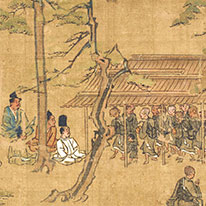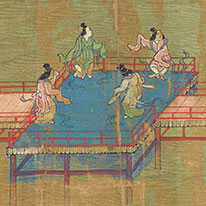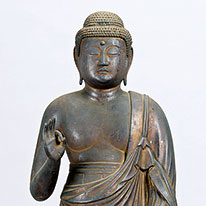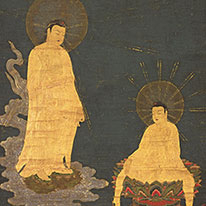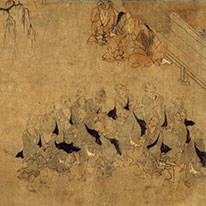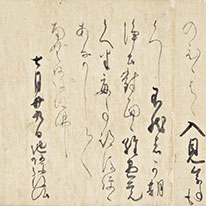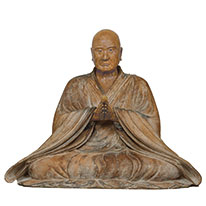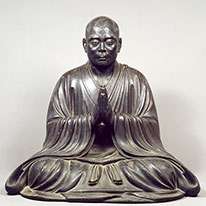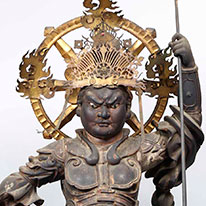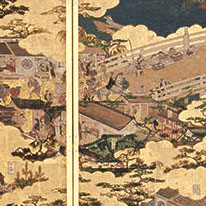General Information
| Exhibition Title | Priest Shinkyō 700th Memorial Special Exhibition Art of the Ji Shū A New Sect of Buddhism in the Kamakura Period |
|---|---|
| Period | April 13-June 9, 2019 The exhibition has two installations: Part I: April 13-May 12, 2019 Part II: May 14-June 9, 2019 Works on view are subject to change without notice. |
| Venue | Kyoto National Museum Heisei Chishinkan Wing |
| Transportation | JR, Kintetsu Railway, Keihan Railway, Hankyu Railway, City Bus |
| Closed | Mondays *Closed Mondays, but when Monday is a national holiday, the museum will be opened on Monday and closed on the following Tuesday. *In 2019, the museum will be opened continuously from Monday, April 29 through Monday, May 6. On Tuesday, May 7, the museum will be closed. |
Special Exhibition Hours | 9:30 a.m.-6:00 p.m. (Entrance Until 5:30 p.m.) Fridays, Saturdays 9:30 a.m.-8:00 p.m. (Entrance Until 7:30 p.m.) |
| Special Exhibition Admission | Adult 1,500 yen (1,300 yen) Univ. Student 1,200 yen (1,000 yen) High School Student 900 yen (700 yen) Admission is free under middle school students. *(Fees in parentheses for groups of twenty or more) |
| Organized by | Kyoto National Museum, The Asahi Shimbun Company, Ji-shū Denomination, Shōjōkō-ji Temple (Yugyō-ji); the head temple of Ji-shū Denomination |
| With the support of | Keihan Holdings Co.,Ltd., Takenaka Corporation |
| With the cooperation of | The Ueno Memorial Foundation for the Study of Buddhist Art, Nippon Kodo Co., Ltd., Sasanami Bunkazai Shurisho(Conservation Center) |
Images from the Exhibit
Ji Shū was a religious sect founded by Ippen (1239-89) in the Kamakura period. A tradition of Japanese Pure Land Buddhism, it is perhaps best known for its tradition of Dancing Nenbutsu (odori nenbutsu)—a practice of dancing while reciting the Buddha's name in an incantatory prayer. Ippen preached that anyone who performed the Nenbutsu would be able to achieve rebirth in the Pure Land (Sukhāvatī), the paradisiacal Buddha realm of Amitābha where the faithful could spend eons in his presence, accruing the karmic benefits of his perpetual expounding of the Buddhist Dharma. Ippen traveled all over Japan propagating this message and handing out talismanic slips of paper sealed with a Nenbutsu prayer (fusan). After Ji Shū had been established as a religious organization, Shinkyō (1237-1319), the second in the lineage following Ippen, made great contributions to the sect's development.
2019 marks the 700th anniversary of Shinkyō's death. On this occasion, we bring together under one roof the great treasures of Ji Shū in a memorial exhibition.
This exhibition introduces Ji Shū visual culture as a whole, encompassing everything from the National Treasure "Illustrated Biography of Priest Ippen" (Ippen hijiri-e) and the picture-scroll "Illustrated Miracle Tales of The Traveling Saint" (Yugyou Shounin engi-e) to portraits and statues of Ippen and successive generations of Ji Shū lineage patriarchs. On top of this, Ippen's illustrated biography will be on view in its entirety, gathering together all twelve of its scrolls. This exemplary work by the priest En'i offers an account of Japan in the middle ages as it depicts the life of Ippen and his travels across the entire country. The exhibition presents new research and several works discovered during the survey conducted in advance of the exhibition as well.
Section I
From Pure Land Teachings to the Ji Shū
The priest Ippen (1239–1289) is regarded as a founder of one of the new Buddhist sects that emerged in the Kamakura period (1185–1333). He emphasized the efficacy of Nenbutsu practice—repeatedly chanting the words Namu Amida Butsu ("Homage to Amida Buddha") as a means of reaching the paradise of Amida (Amitābha) Buddha's Pure Land after death. In part for the expeditious path to the Pure Land that Ippen promised, the tradition he founded is called Ji Shū—the Time Sect. The methods and beliefs that Ippen popularized were informed by various influences: the teachings of the Tang dynasty Chinese priest Shandao (603–681), Japanese traditions of Pure Land (Jōdo) Buddhism to which these teachings were foundational, his personal experiences of itinerant practice, and the imagery known as the "White Path between Two Rivers" that he encountered at Zenkō-ji Temple. At Kumano Shrine, meanwhile, Ippen received the oracle of one of its deities, Kumano Gongen. The works of this first section provide something of the context within which Ippen founded his movement.
Section II
The Teachings of the Ji Shū: From Ippen to Shinkyō
Compared to other sects emerging in the Kamakura period (1185–1333), such as the Pure Land (Jōdo), Nichiren, and Zen traditions, the Ji Shū was a latecomer. It arrived only after 1274, when Ippen received an oracle from one of the avatars of the Kumano Shrine deity, Kumano Gongen. Yet Ippen's movement caught on quickly, in part due to his travels throughout the entire country to spread his teachings. Objects embodying the Ji Shū in its early days can be found in this section. In addition to the sets of handscrolls illustrating Ippen's itinerant practice and the Six-Character Homage to the Sacred Name of Amida hanging scrolls, these include rustic hempen priests'robes (ami'e), gongs (shōko), and the proprietary chests that he and his followers took with them as they travelled. Upon Ippen’s death, his disciple Shinkyō (1237–1319) formalized Ippen’s teachings and organized those drawn to the nascent tradition to found the Ji Shū.
Section III
Illustrated Biography of the Priest Ippen
—The National Treasure Handscrolls and Related Works
This section introduces all twelve handscrolls of the National Treasure Illustrated Biography of the Priest Ippen (Ippen hjiri-e), providing a rare opportunity to view this masterwork of medieval painting in its entirety. The scrolls together depict forty-eight scenes, and seem to have been completed on the tenth anniversary of Ippen's death. They offer a visual account of Ippen's life and good works, featuring the places that Ippen visited and detailed renderings of the people who lived there. Little is known about En'i, who combined the vivid pigments of Japanese-style yamato-e painting with vanguard ink monochrome techniques in painting these scrolls. We know only that he was a priest—which we can tell from the title "Hōgen" in his signature. His images complement textual passages compiled by Ippen's disciple Shōkai (1261–1323) relating his teacher's journeys and teachings.
-
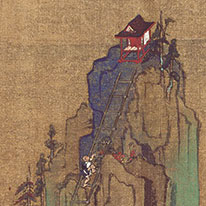
- National Treasure
Illustrated Biography of the Priest Ippen (Ippen hijiri-e) Vol. 2
By En'i
Shōjōkō-ji (Yugyō-ji) Temple, Kanagawa
[this section on view: April 13-May 12, 2019]
-
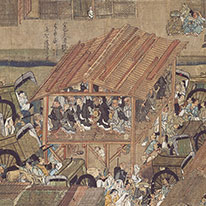
- National Treasure
Illustrated Biography of the Priest Ippen (Ippen hijiri-e) Vol. 7
By En'i
Tokyo National Museum
[on view: April 13-May 12, 2019]
-
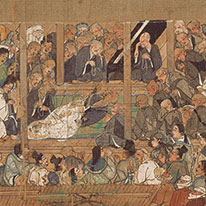
- National Treasure
Illustrated Biography of the Priest Ippen (Ippen hijiri-e) Vol. 12
By En'i
Shōjōkō-ji (Yugyō-ji) Temple, Kanagawa
[this section on view: May 14-June 9, 2019]
Section IV
Later Patriarchs of the Ji Shū and Expansion through Itinerant Practice
The priest Shinkyō, regarded as the second Ji Shū patriarch, passed the title of Yugyō Shōnin ("Venerable Itinerant Priest") to his disciple, Chitoku. This title was then passed down through several generations of the Ji Shū lineage—a lineage essential to the Ji Shū identity. They expanded the Ji Shū presence by means of itinerant practice and the founding of new dōjō. The Shichijō Dōjō in Kyoto—which was located not far from the present site of this museum—served as the home base to the early Ji Shū patriarchs as they traveled throughout Japan. In this section, we see the Yugyō Shōnin and Ji Shū patriarchs through their preserved writings and their portraits, either sculptural or painted. The statuary portraits of leading Shichijō Dōjō figures were largely done by prominent Buddhist sculptors (busshi) in the lineage of the master Buddhist sculptor Unkei. Based at a nearby workshop, the so-called Shichijō Busshi portrayed the Ji Shū patriarchs with a striking naturalism that suggests they created their portraits with direct access to their subjects.
Section V
Dōjō—Ji Shū Temples and Their Treasures
In the Ji Shū tradition, training temples are known as dōjō, "places of practice." Ji Shū dōjō were built in key locations around the country. Some of the most prominent dōjō were founded by the early Ji Shū patriarchs in the Kantō region of Japan, which includes Tokyo (formerly Edo) and Kamakura, and in Kyoto. This section focuses on treasures associated with Ji Shū dōjō, particularly those in Shiga prefecture, Fujisawa, and Kyoto. The many works in this section encompass principle objects of worship at the various dōjō, for which reason they are seldom loaned to exhibitions. The section also features an Amida Triad recently discovered to be a work by Gyōkai, the most important disciple of the master Kamakura-period Buddhist sculptor Kaikei (?–prior to 1227). Finally, the section includes folding screens of the Scenes in and around the Capital (Rakuchū rakugai-zu) genre that feature dōjō and the activities surrounding them.











